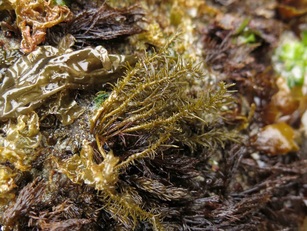Fir needle, bottlebrush seaweed, fir branch, sea fir • Analipus japonicus
|
Left: photo by Jenn Burt. Right: specimen collection number SCL 15354 in the UBC Herbarium Algae Database. Image courtesy of Sandra Lindstrom. Search the collection number in the database for further details on this specimen or search this species for additional occurrences.
|
Identification
This perennial brown alga has an overwintering crustose base from which upright branches (the thallus) arise. These branches grow to 35 cm tall and bear many radially-arranged side branches, which may be somewhat flattened or curled. Branches begin growing in spring and die back in fall. The crustose base, which acts as a holdfast, gets to 5 cm in diameter and may last several years. Click here for more detailed identification information, and see AlgaeBase for more photos.
Habitat & Range
This species grows on rocks in the mid- to low-intertidal, on semi-protected to directly exposed shores from the Aleutian Islands to California. It is also found along coastlines of Korea, Japan, and Russia.
Human Uses
Fir needle is used in Japanese cuisine.
Intriguing Info
The golden bottlebrush epiphyte (Saundersella simplex) often grows on fir needle and can almost obscure it from sight.
This perennial brown alga has an overwintering crustose base from which upright branches (the thallus) arise. These branches grow to 35 cm tall and bear many radially-arranged side branches, which may be somewhat flattened or curled. Branches begin growing in spring and die back in fall. The crustose base, which acts as a holdfast, gets to 5 cm in diameter and may last several years. Click here for more detailed identification information, and see AlgaeBase for more photos.
Habitat & Range
This species grows on rocks in the mid- to low-intertidal, on semi-protected to directly exposed shores from the Aleutian Islands to California. It is also found along coastlines of Korea, Japan, and Russia.
Human Uses
Fir needle is used in Japanese cuisine.
Intriguing Info
The golden bottlebrush epiphyte (Saundersella simplex) often grows on fir needle and can almost obscure it from sight.
References
Lamb, A., and Hanby, B. (2005). Marine Life of the Pacific Northwest [electronic version]. Madeira Park, BC: Harbour Publishing.
Lindberg, M. and Lindstrom, S. (2010). Analipus japonicus. Seaweeds of Alaska. Accessed 26/11/2014.
O'Clair, R. and Lindstrom, S. Analipus japonicus (Harvey) Wynne. In Klinkenberg, Brian. (Ed.). E-Flora BC: Electronic Atlas of the Plants of British Columbia. Lab for Advanced Spatial Analysis, Department of Geography, University of British Columbia, Vancouver. Accessed 26/11/2014.
Authors and editors of page
Kelly Fretwell and Brian Starzomski (2014).
Lamb, A., and Hanby, B. (2005). Marine Life of the Pacific Northwest [electronic version]. Madeira Park, BC: Harbour Publishing.
Lindberg, M. and Lindstrom, S. (2010). Analipus japonicus. Seaweeds of Alaska. Accessed 26/11/2014.
O'Clair, R. and Lindstrom, S. Analipus japonicus (Harvey) Wynne. In Klinkenberg, Brian. (Ed.). E-Flora BC: Electronic Atlas of the Plants of British Columbia. Lab for Advanced Spatial Analysis, Department of Geography, University of British Columbia, Vancouver. Accessed 26/11/2014.
Authors and editors of page
Kelly Fretwell and Brian Starzomski (2014).





